An Analysis of Marketing Strategies and Practices
of Aftab Bahumukhi Farm Limited
Aftab Bahumukhi Farms Ltd. (ABFL) was established in 1991 by AL-Haj Jahural Islam, the founder chairman of Islam Group. To adapt the changes and meet the demand of 21st century this farm has a modern poultry processing plant, the first of its kind in Bangladesh, with the capacity to process 1000 (One thousand) birds per hour, equipped with modern amenities. Aftab Bahumukhi Farm has also established further processing plant to supply ready to cook chicken based items in the city markets. ABFL has more than 22(Twenty two) different processed and further processed products. Moreover, Aftab products are the present market leader for both processed and further processed chicken products.
However, after analyzing the industry information and visiting the company sales center had given me the feel that there are huge lacking in the marketing strategies and practices. To find out the existing problems of Aftab Bahumukhi Farms Ltd. (ABFL) in terms of its major products, processed and further processed chicken items, and to find out better ways, this research paper is directed. In this study a market share analysis as well as analysis of competitors who have the similar products in the market is made.
Market share analysis and competitor analysis is conducted based on the competitors marketing practices. This research is conducted as a descriptive research on selected sample size and industry members. The major competitors of the processed chicken products of Aftab Bahumukhi Farms Ltd. are BRAC, Whitehen and so many non brand farms. The largest pie of the processed chicken product’s market share is occupied by the non branded farms. The main strengths of the non branded farms are the low price and high availability. The nearest competitor is BRAC. Though Aftab produces the highest quality product, lack of proper marketing strategies and communication, it is losing important market shares. Aftab only occupies 16%of the total market share where as non branded farms have 61% market shares.
In terms of further processed Chicken products Rich brand of Harvest Rich Group has the largest market shares. Rich occupies 70% of total market share whereas Afatb occupies only 20% of the market shares. The marketing strategies of Rich brand are better planned and successful in terms of branding, packaging, promotion and distribution than Aftab Bahumukhi Farms Ltd. Even Aftab Bahumukhi Farms Ltd does not have separate marketing and sales team. And the amount of promotional activities are performed by the company is very poor compared to its competitors. The Kazi Farm, Nourish Agro and Cp are the new entrants in this industry. But their marketing efforts are quite impressive and well planned.
Aftab Bahumukhi Farm has enough resources in terms of its competitors. And already the company has the brand image of Quality Producer. In the last part of the report a SWOT analysis is made to present the company’s strengths and opportunities as well as weakness in terms of competitors. And a set of marketing strategies are developed which will deliberately help the management to overcome the present inefficiencies.
Introduction
The growth of poultry industry during the last few years is one of the remarkable successes stories of Bangladesh. New technologies have been introduced, and production has shot up in day old chick, broiler and egg sectors.
Bangladesh is a country with abundance of labour forces awaiting opportunities for gainful employment. Its people of either sex constitute a bank of human resource. By utilizing these resources in a befitting and dignified manner, significant changes can be brought about in the economy of Bangladesh, which is overwhelmingly rural and agrobased.
Toward 1991, the Islam Group from its initial interest in poultry development sector formed Aftab Bahumukhi Farms Limited (ABFL) and subsequently became active as a multinational conglomerate. With the aim of continuous Progress of Aftab Bahumukhi Farms Ltd. Aftab Hatchery Ltd. (AHL) was established in 2001 for parent stock rearing and producing day old commercial chicks and the single largest Feed Mill of the country emerged as Aftab Feed products Ltd. (AFPL) in 2003. Moreover, Aftab G.P. Farms Ltd. (AGPFL) was established in 2006 for Grand Parent rearing and for producing parent day old chicks.
Aftab Bahumukhi Farms Ltd. (ABFL) is the only integrated and largest poultry industry in Bangladesh that maintains the whole poultry chain from Grand Parent to further processed Chicken.
Organization profile
Aftab Bahumukhi Farms Ltd (ABFL), is located at Bhaghalpur, an emerging picturesque village under the Bajitpur police station in the district of Kishorganj, a locality suitable for ideal farming. It is the birth –place of late Al-Haj Jahural Islam, the founder chairman of Islam Group and the philanthropist and industrialist of international repute. There are many educational and charitable institutions in Bhagahalpur established and running under the patronage of Islam Group. As a result the village has been emerging as an ever growing town. ABFL was established with the dual purpose of providing permanent financial backup to the educational institutions, the Jahurul Islam Medical College and Hospital in particular and succor to the poor people of the locality creating job opportunities and self employment in general, which in turn is also helping in poverty alleviation.
With the aim of continuous progress of Aftab Bahumukhi Farms Ltd., Aftab Hatchery Ltd. (AHL) was established in 2001 for Parent Stock rearing and producing Day Old Commercial Chicks (DOC) and the single largest Feed Mill of the country emerged as Aftab Feed Products Ltd. (AFPL) in 2003. Moreover, Aftab G.P. Farms Ltd. (AGPFL) was established in 2006 for Grand Parent rearing for producing parent day old chicks.
Poultry
ABFL is the only integrated and the largest poultry industry in Bangladesh that maintains the whole poultry chain from Grand Parent to Further Processed Chicken.
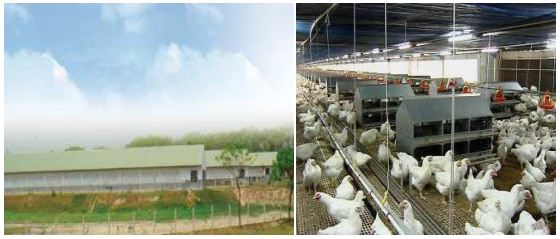
Grand Parent
Aftab G.P. Farms ltd. (AGPFL) has established Grand Parent Stock Farms at Sararchar under the Bajitpurthana of Kishorgoanj district. The first Parent stock has been produced during the end of the February-2006; resulting dependency on import of the parent stock Day Old Chicks from European countries. Now Bangladesh is selfdepended as regards Parent Stock farming. AGPFL housed about 20000. G.P. at 4 fully environment controlled G.P. Farms Sheds. Present monthly production is around 60000 P.S. DOC. AGPFL had successfully exported day old chicks to the Middle East and Nepal.
Grand Parent Hatchery
The Grand Parent Hatchery has a full set of automatic state-of-art machinery to ensure the highest international standard of quality Parent Chicks. It has a production capacity of 1, 20,000 Parent stock DOC per month.
Parent Stock
Aftab Hatchery Ltd. (AHL) has several Parent Stock (P.S.) farms which maintain four hundred thousand (4, 00,000) broiler and layer parent stocks. These parent stocks were produced by itsown G.P. Farms. Around 30% of the parent stocks are maintained by AHL’s own management, in semi controlled and controlled houses. The remaining 70% are maintained by selected contracted growers. AHL introduced parent stock farming under contract growing system for the first time in South Asia. Under its system an unemployed farmer becomes an employer. ABFL provides the expensive day old breeder chicks to the contract growers on credit and supplies them feed, medicine, vaccine etc. also on credit.
After 22/24 weeks onward the birds start laying eggs and ABFL buys back the hatching eggs at fixed rate even when the price of the eggs plunges down. At present 122 contract growers with a capacity of 2500-3000 are under AHL activities in six upozillas of Kishorgonj district.
A part from the two or three supervisors who stay full time in each farm, veterinary
doctors and animal husbandry graduates always monitor the activities and give necessary support to the farmers. Routine health tests are also conducted by specialized veterinarian in ABFL’s own diagnostic laboratory.
Commercial Hatchery
Aftab hatchery Ltd. (AHL) started its activities separately from ABFL in the view of its huge expansion. AHL believes that production of quality chicks is the prime factor for success of any poultry farm.
Initially one hatchery was established in Bhagalpur with production capacity of five hundred thousand (5, 00,000) DOC per month only. To meet the increased demand of Aftab Chicks AHL was established in 2003, the largest single hatchery complex of our country having production capacity of 3.2 million DOCs per month at the Kamalpur under Kishorgonj district. The day old commercial broiler and layer chicks are marketed throughout the country by Aftab’s own distribution network.
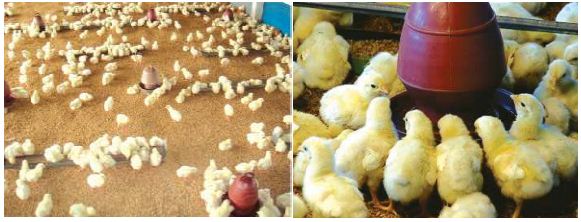
Commercial Broiler operation
Since its inception Bhagalpur village turns into a center of all ABFL activities. It had its effect in the area, causing changes in thinking and attitude among the rural populace of the area. They started taking interest in poultry farming and became eager to obtain its know-how and take part in its commercial production. Because of fund constraint the majority of the local people could not take the initiative despite their interest. The management of ABFL could not simply let the genuine enthusiasm of the people fade away and wanted to intervene in a manner, which would be both meaningful and beneficial to all involved parties.
From its inception ABFL has delivered day old chicks, feed and medicine to selected contracted growers and buying back the broilers at the fair price and sold the same as in Dhaka city. ABFL’s doctors and technical personnel provide technical support to the farms at free charge. At present there are around 500 contract growers with the capacity of rearing 1000 to 3000 birds in each farm.
Poultry processing plant
To adapt the changes and meet the demand of the 21st century a modern poultry processing plant, the first of its kind in Bangladesh, with the capacity to process 1000 birds per hour, equipped with the plants and machinery of the world famous STORK Company of Netherlands was commissioned by ABFL at Bajitpur. The poultry processing plant having latest technique and expertise in the field of poultry processing ensures quality and hygienic products. The poultry processing plant has automatic overhead conveyor, 4-stage scalder, plucker, spray muzzle and a fully automatic disinfection system envisaging bacteria free products. All these activities are being done in a HALAL way.
Further Processing Plant
ABFL established further processing plant to supply ready to cook chicken based items in the city markets. Now it is producing Chicken Nuggets, Burger Patties, Tandori Nuggets, Crispy Wing, Fried Drumstick and ShammiKabab, which are the most prominent items of this operation. ABFL has consolidated its resources to export Dressed Bird and Further Processed items of Broiler like Chicken Nuggets, Burger Patties, Tandori Nuggets etc. ABFL always ensures to modernization of its machinery range and introduces new products to meet the demand of the valued customers.
Feed Mills
AFTAB produces poultry feed, fish feed and cattle feed in its modern mills and distributes them all over the country through its own distribution network.
Poultry Feed
With the rapid expansion of poultry related activities in the country, the necessity of modern feed mills for commercial production balanced disease-free poultry feed was strongly felt. To meet the demand for poultry feed ABFL has started production in 1996 with an initial capacity of 2.5 tons per hour palleted poultry feed for international standard. Due to continuous increasing demand ABFL and Aftab Feed Products ltd. (AFPL) had commissioned feed mills one after another and with its recent expansion the capacity now stands at 25000 MT per month ABFL and AFPL maintain warehouse of different capacity for storing 50000MT ingredients, which includes 7 grain silos at different places.
High quality ingredients are used to produce feeds and the microelements are imported directly from world- reputed manufactures to ensure quality. All ingredients and elements are also tested in Aftab’s quality control laboratory having sophisticated equipment. The quality of each batch of feed is controlled and ensured. Apart from that regular trails are also conducted in its own R&D farm to evaluate the performance of the product.
Fish Feed
Quality feed play a vital role for success of fish production and taking this into consideration ABFL and AFPL have created facilities for producing quality fish feed side by side with poultry feed.
To meet the growing demand of quality fish feed AFPL commissioned a dedicated specialized fish feed mill for producing Sinking Fish Feed, Floating Fish Feed and Shrimp Feed having capacity of 5000MT per month.
Cattle feed
Shortage of grazing land is the major problem for cattle feeding in Bangladesh. Successful cattle production in Bangladesh will depend on compound feed in the coming future. Providing a well balanced ratio at a reasonable price is increasingly complex due to higher price of raw materials. Considering this factors ABFL has started production and marketing of cattle feed.
Crops
Bangladesh is naturally rich due to its plain fertile lands, which is best production of crops. Many types of crops are available here in Bangladesh such as cereals, vegetables, pulses, oils etc. ABFL also involves itself for crops developments and is entrusted with production, processing and marketing of quality seeds.
Seed
Due to lack of quality seeds, crop production in Bangladesh cannot reach the desired level. To ensure supply of quality rice seed and to increase its production ABFL started a joint collaborative program in the year 2001 with Yuan Long Ping High Tech Agriculture Co. Ltd. Of China, Prof. Yuan Long Ping who is considered the father off hybrid rice in the People’s Republic of China. ABFL’s main activities are on hybrid rich seed. ABFL have been producing and marketing hybrid rice seed for last five years.
At present, ABFL imports five hybrid rice varieties from LPHT, China, which are LP50, LP70, LP108, LP106 and LP05. ABFL started other seed production and are marketing the same besides hybrid rice seed which are High Yielding Rice Varieties, Hybrid Maize, Hybrid Chili, Hybrid Tomato, and Jute and so on.
As Bangladesh population is growing, demand of each category of food items are increasing day by day, while cultivated land and its fertility is declining. Therefore, greater agricultural productivity is not only a necessity but an imperative. Aftab Bahumukhi Farms Ltd. (ABFL) is trying to play a very important role to ensure food security for the people of Bangladesh by providing good quality seeds.
Commercial Agricultural Farming
The objective of this program is to help our rural poor to cultivate Hybrid Rich Seed by providing modern agricultural inputs such as Seed, fertilizer and pesticide through ABFL. The proposed projected area of this program is 01 lakh acres. It will be located at different places in northern part of Bangladesh. The production procedure of this program will be on contract growing system.
AFBL’s main goal of this project is to motivate the farmers about commercial farming of high yielding variety of rice. The company hopes that this program will ultimately help ABFL to contribute in food security program for the whole nation. If ABFL can implement this project successfully, the country will ultimately be able to export rice after fulfillment of local demands.
Fisheries
Pisciculture is another important profit earning sector for the rural population of Bangladesh. ABFL do not keep aloof from this enormous sector for improvement of living standard of the rural people.
But ABFL is at the initial stage in developing its fisheries sector. It owns 50 pounds and their total water area cover 40 acres. Monthly production capacity is around 10 tons. ABFL mainly produces carp, catfish, tilapia and pungush.
SWOT Analysis ofAftab Bahumukhi Farms Ltd
Strengths:
Marketing
- Company and parent group reputation is very high.
- Already a market challenger in processed chicken market
- Have some reputation in further processed chicken market.
- Products are available in key super-malls.
- Higher class of A category customers are aware of the products.
- Financials
- Financial strength of the company is very strong.
- It’s possible to make promotional expenses as sales begin.
- Cost of availability of capital is low.
Organization
- Management of the company is eager to build a strong organizational set-up to build up the market.
- Skilled and experienced manpower in the production facility exists.
Weaknesses:
Marketing
- There is a significant confusion raised among consumers regarding Aftab consumer products and chicken products.
- New brand name sub-brand names are necessary and urgent to be developed.
- Only highest category super-malls currently carry Aftab chicken further processed products and existing product pricing is out of reach of middle class population due to larger pack sizes only.
- Brand perception seeing the current product packaging is worse compared to the main competitor, Rich brand.
- Net proper support from factory. Sometimes products supplied from the factory do not with the order requirements.
- Product size disorders are another important problem
- There is no marketing and Branding team in the company.
- Paper packs of the key products are hard to store in the refrigerator and most of the times they are torn.
- Product packaging needs a over- hauling to increase its standard, to meet international and local regularities, and make them attractive to the endconsumers.
- New products need to be launched to meet the need of two segments of consumers; one for higher class and the other for middle class population.
Objectives
The main objective of this study is to evaluate the performance of Aftab Bahumukhi Farms Ltd. (ABFL) based on marketing strategies and practices and pointing the ways to be more competitive as well as a projection of the company for the next following the industry it belongs. This study will help in realizing the present company status in terms of competitors and what strategies will be helpful to resolve the existing problems.
Market Share:
Market share is the proportion of total sales of a product during a stated time period in a specific market that is captured by a single farm (Etzel,Walker, Stanton, 1997). A firm’s percentage of the total sales volume generated by all competitors in a given market (Bagozzi, Rosa, Kirti, Chelly, Coronel, 1998). Cravens and Piercy (2003) stated that company sales divided by the total sales of all firms for a specified product market determine the market share of a particular firm.
They also stated that market share can be used to forecast future company sales and to compare actual market position among competing brands of a product. It can be the ratio of sales revenue of the firm to the total sales revenue of all firms in the industry, including the firm itself (Farase, Kimbrell, Woloszyk). According to Kotler (2003) company sales do not reveal how well the company is performing relative to competitors. For this purpose, management needs to track its market share. He also stated that market share can be measured in 3 ways: (1) overall market share (2) served market share (3) relative market share. According to him overall market share is the company’s sales expressed as a percentage of total market sales. Relative market share can be expressed as market share in relation to its largest competitor. A relative market share over 100 percent indicates a market leader.
According to Cravens and Piercy (2003) relative market share is measured by comparing the share of the firm against that of the competitor with the highest market share in the segment.
Competitor Analysis:
Competitor analysis is an organized approach for evaluating the strengths and weaknesses of current or potential competitors’ marketing strategies (Perreault, McCarthy, 1996). They also stated competitive rivals as a firm’s closest competitors.
According to Farese, Kimbrell, Woloszyk analyzing competition means listing all the competitors in trading area along with their type of products, prices, locations, general quality of products and their strengths and weaknesses. Determining competitors’ sales volume and how they promote and sell the products. Showing how the firm’s business will be superior to the competitor based on these factors.B AGozzi, Rosa Kirti, Chelly, Coronel (1998) stated that analysis of the competition is as important as study of the consumer. The goal is to meet customer needs with a product or service that achieves a differential advantage over the competitor. Cravens and Piercy (2003) stated that competitor analysis is conducted for farms that compete directly with each other (e.g. Nike & Reebok) and other companies that management may consider important in strategy analysis (for example, potential market entrants). He proposed two major aspects of competitor analysis: (1) preparing the descriptive profile for each competitor and (2) evaluating the competitors’ strengths and weaknesses. Kotler (2003) stated that competitors are companies that satisfy the same customer need. The market concept of competition reveals a broader set of actual and potential competitors. He also added that once a company identifies its primary competitors, it must ascertain their characteristics, specifically, their strategies, objectives, strengths and weaknesses, and reaction pattern. Rothschild (1979) suggested following questions to ask about a competitor who is the competitor now and who will it be in the future? What are the key competitor’s strategies, objectives and goals? How important is a specific market to the competitors and are they committed enough to continue to invest? What unique strengths do the competitors have? Do they have any weaknesses that make them vulnerable? What changes are likely in the competitors’ future strategies? What are the implications of competitors’ strategies on the market, the industry and one’s own company? Following Rothchild’s (1979) advice J. Baker (2000) stated that in an ideal world one would seek to document competitive firms in as much detail as possible.
According to West (1999) a typical competitor information profile will cover ownership and organizational structure; financial history, financial resources, key decision makers and their track records, staff resources, production resources and locations, product lines and portfolios, patents, licenses and other unique assets; markets and segment serviced; distribution channel used; export activity and country supplied; sales and marketing activities. He also stated that the depth and quality of information available varies considerably from market sector to market sector and from country to country.
Kotler (2003) stated, a company needed to gather information on each competitor’s strengths and weaknesses. According to the Arthur D. little (1974) a company will occupy one of six competitive positions in the target market.
- Dominant: This firm controls the behavior of other competitors and has a wide choice of strategic options.
- Strong: This firm can take independent action without endangering its long-term position and can maintain its long-term position regardless of competitors’ actions.
- Favorable: this firm has an exploitable strength and a more-than- average opportunity to improve its position.
- Tenable: This farm is performing at a sufficiently satisfactory level to warrant continuing in business, but it exists at the sufferance of the dominant company and has a lessthan-average opportunity to improve its position.
- Weak: this firm has unsatisfactory performance, but an opportunity exists for improvement. The firm must change or else exit.
- Nonviable: this firm has unsatisfactory performance and no opportunity for improvement. Kotler (2003) supporting the Arthur D. Little (1974) assessment stated that this assessment helped one company decide whom to attack in the programmable controls market.
Marketing
According to Kotler (2009), Marketing is the process used to determine what products or services may be of interest to customers, and the strategy to use in sales, communications and business development. It generates the strategy that underlies sales techniques, business communication, and business developments. It is an integrated process through which companies build strong customer relationships and create value for their customers and for themselves.
Marketing is used to identify the customer, satisfy the customer, and keep the customer.
With the customer as the focus of its activities, marketing management is one of the major components of business management. Marketing evolved to meet the stasis in developing new markets caused by mature markets and overcapacities in the last 2-3 centuries. The adoption of marketing strategies requires businesses to shift their focus from production to the perceived needs and wants of their customers as the means of staying profitable.
Gray Armstrong and Kotler (2008) also stated that the term marketing concept holds that achieving organizational goals depends on knowing the needs and wants of target markets and delivering the desired satisfactions. It proposes that in order to satisfy its organizational objectives, an organization should anticipate the needs and wants of consumers and satisfy these more effectively than competitors.
Marketing is further defined by the AMA as an organizational function and a set of processes for creating, communicating, and delivering value to customers and for managing customer relationships in ways that benefit the organization and its stakeholders. The term developed from an original meaning which referred literally to going to a market to buy or sell goods or services. Seen from a systems point of view, sales process engineering marketing is “a set of processes that are interconnected and interdependent with other functions, whose methods can be improved using a variety of relatively new approaches.”
The Chartered Institute of Marketing defines marketing as “the management process responsible for identifying, anticipating and satisfying customer requirements profitably.”A different concept is the value-based marketing which states the role of marketing to contribute to increasing shareholder value. In this context, Paliwoda, Stanly J (2009) stated that marketing is defined as “the management process that seeks to maximize returns to shareholders by developing relationships with valued customers and creating a competitive advantage.”
Marketing practice tended to be seen as a creative industry in the past, which included advertising, distribution and selling. However, because the academic study of marketing makes extensive use of social sciences, psychology, sociology, mathematics, economics, anthropology and neuroscience, the profession is now widely recognized as a science, allowing numerous universities to offer Master-of-Science (MSc) programs.
The overall process starts with marketing research and goes through market segmentation, business planning and execution, ending with pre- and post-sales promotional activities. It is also related to many of the creative arts. The marketing literature is also adept at re-inventing itself and its vocabulary according to the times and the culture.
Marketing strategies
Baker (2008) stated that Marketing Strategy is a process that can allow an organization to concentrate its limited resources on the greatest opportunities to increase sales and achieve a sustainable competitive advantage.
Marketing strategies serve as the fundamental underpinning of marketing plans designed to fill market needs and reach marketing objectives. Plans and objectives are generally tested for measurable results. Commonly, marketing strategies are developed as multi-year plans, with a tactical plan detailing specific actions to be accomplished in the current year. Aaker (2008) agreed that time horizons covered by the marketing plan vary by company, by industry, and by nation, however, time horizons are becoming shorter as the speed of change in the environment increases. Marketing strategies are dynamic and interactive. They are partially planned and partially unplanned.
Hausman Marketing letter Definition of marketing series suggested that Marketing strategy involves careful scanning of the internal and external environments which are summarized in a SWOT analysis. And, supporting that Aaker (2008) stated that internal environmental factors include the marketing mix, plus performance analysis and strategic constraints. External environmental factors include customer analysis, competitor analysis, target market analysis, as well as evaluation of any elements of the technological, economic, cultural or political/legal environment likely to impact success.
A key component of marketing strategy is often to keep marketing in line with a company’s overarching mission statement Besides SWOT analysis, portfolio analyses such as the GE/McKinsey matrix or COPE analysis can be performed to determine the strategic focus.
Once a thorough environmental scan is complete, a strategic plan can be constructed to identify business alternatives, establish challenging goals, determine the optimal marketing mix to attain these goals, and detail implementation. A final step in developing a marketing strategy is to create a plan to monitor progress and a set of contingencies if problems arise in the implementation of the plan.
Marketing Mix
A planned mix of the controllable elements of a product’smarketing plan commonly termed as 4Ps: product, price, place, and promotion.
The term “marketing mix” was coined in 1953 by Neil Borden in his American Marketing Association presidential address. However, this was actually a reformulation of an earlier idea by his associate, James Culliton, who in 1948 described the role of the marketing manager as a “mixer of ingredients”, who sometimes follows recipes prepared by others, sometimes prepares his own recipe as he goes along, sometimes adapts a recipe from immediately available ingredients, and at other times invents new ingredients no one else has tried. The marketing mix (price, product, distribution, promotion) forms the entire promotional campaign. As stated in “Management of a Sales Force” by Rosann L. Spiro, Gregory A. Rich, William J. Stanton, “when these are effectively blended, they form a marketing program that provides want-satisfying goods and services for the company’s market.”
The term became popular in the article written by Niel Borden called, “The Concept of the Marketing Mix,” as explained on the site netmba.com. He started teaching the term too many after he himself learned about it with an associate of his. The marketing mix is a broad concept which includes several aspects of marketing which all inquire to obtain a similar goal of creating awareness and customer loyalty. The marketing mix is not only an important concept, but a guideline to reference back to when implementing the price, promotion, product, and distribution. Those are the four main ingredients of the marketing mix, but there are other components including, planning, branding, packaging, display, distribution channels, personal selling, advertising, servicing, and physical handling. All in all the current description of the marketing mix is accurate, but missing some vital pieces of information which will allow individuals to gain a better understanding and implement a more effective marketing mix. A prominent marketer, E. Jerome McCarthy, proposed a Four P classification in 1960, which has seen wide use.
Four ‘P’s
Elements of the marketing mix are often referred to as the “Four ‘P’s”, a phrase used since the 1960’s
Product – It is a tangible good or an intangible service that is mass produced or manufactured on a large scale with a specific volume of units. Intangible products are service based like the tourism industry& the hotel industry or codes-based products like cellphone load and credits. Typical examples of a mass produced tangible object are the motor car and the disposable razor. A less obvious but ubiquitous mass produced service is a computer operating system. Packaging also needs to be taken into consideration. Every product is subject to a life-cycle including a growth phase followed by an eventual period of decline as the product approaches market saturation. To retain its competitiveness in the market, product differentiation is required and is one of the strategies to differentiate a product from its competitors.
Price – The price is the amount a customer pays for the product. The business may increase or decrease the price of product if other stores have the same product.
Place – Place represents the location where a product can be purchased. It is often referred to as the distribution channel. It can include any physical store as well as virtualstores on the Internet.
Promotion – Promotion represents all of the communications that a marketer may use in the marketplace. Promotion has four distinct elements: advertising, public relations, personal selling and sales promotion.
Competitor assessment with critical success factors:
John Stapleton (1987) suggested that the most appropriate means for assessing competition is in truly financial terms as this enables comparisons to be made and a standard to be developed against which the firm’s own performance can be measured.
To structure such an analysis Stapleton proposes 9 different indicators. But in contrast with West (1999) Baker (2000) stated that simple summary diagrams are often much more illuminating than pages of statistics he recommended the use of profiling diagrams. John Saunders (1995) stated such profiling diagrams as a ‘competitor assessment grid’. And supporting him Baker (2000) constructed such a profile and stated to construct such a profile by using the critical success factors, which are important in the industry/ market under consideration. Baker (2000) stated that having drawn up a list of the closest competitor’s staff evaluated each of these relative to themselves in terms of each of the key success factors. He also stated that one can identify a list of critical success factors and assemble enough data to make comparative judgments of competing firms in terms of these factors; this will provide decision makers with a powerful diagnostic tool. Baker (2000) also stated that in strengths and weaknesses assessment technique some information can be overlooked so it is vitalto reduce the output of our appreciation to the bare essentials. He also stated that obviously this will require the exercise of judgment and it will usually be necessary to priorities the relative importance of the factors under consideration. Either verbal or numerical scaling with only the critical factors being included in the final analysis may do this. According to Grunert and Ellegaard (1993) the idea that there are few factors which are decisive for the success of the company, and that these factors can be ascertained, was first introduced by Daniel (1961) and later mainly elaborated by Rockart (1979); Bullen and Rockert (1981) in the context of designing management information systems’. The identification of critical success factors was prompted by the observation that many senior managers did not make use of the formal management information systems. In turn, this led to the conclusion that this was due to the fact that these systems were unnecessarily complex and should be structured around a smaller number of what they called critical success factors. According to Rockart (1979) there are five sources of critical success factors: the industry, competitive strategy and industry position, environmental factors, temporal factors, and managerial position.
Marketing Mix of Aftab Bahumukhi Farms Limited
Product lists with price
ABFL has more than 22(Twenty two) different processed and further processed products. These products are sold in two different categories. There are general category for all consumers and customized category. At present customized products are sold only to KFC.
Aftab’s products are priced to capture the higher income customers. Though the company is looking forward to cover all income levels, quality maintenance is the main objective of this company. And for such higher quality management, KFC became the regular customer for processed products of Aftab. KFC also has the worldwide brand image of quality producer.
Place
Aftab products are currently marketed in six major cities: Dhaka, Chittagong, Shylet, Naraongonj, Cox’s Bazaar and Feni. The company is actively making attempts to market products all over Bangladesh as well as in international markets. However, the major sales activities are practiced in Dhaka city.
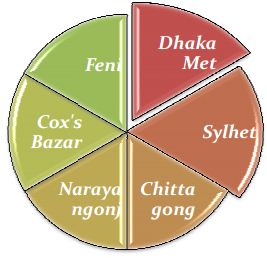
Promotion
Aftab Bahumukhi Farms Ltd. has own brand of processed and further processed products under the brand name of “Aftab”. Aftab brand is already a market challengers in processed chicken markets almost enjoys 25% market share. For a substantial period of around 6(six) years it has been giving it’s further processed items in the market but enough penetration level has not yet been achieved. Mainly due to lacking in sales, branding and overall marketing efforts. Though Aftab’s products are considered number one quality products and the company has modern procedures and machineries, there is no well planned marketing and promotional efforts.
Up to July, 2011 the company only arranged few promotional activities for both processed and further processed products.
Marketing Mix limitations of Aftab Bahumukhi Farms Limited
There is a huge gap between the company’s mission and the marketing activities performed. Aftab Bahumukhi Farms ltd is the largest and the only integrated poultry industry in Bangladesh that maintains the whole poultry chain from Grand Parent to Further Processed Chicken. But the company has no well planned marketing strategies and practices. Even in the DOC production and sales, Kazi Farm of Kazi Groups enjoys the largest market share.
There was a study conducted by ShamimaAfrozBubli in 2006, a marketing executive of Kazi farm. That paper was directed towards exploring the market share and major competitors of Kazi Farms Group in the DOC1 Broiler production of Bangladesh poultry market. Kazi farm is the poultry farm sales chicks and feed and import GP. A qualitative research was conducted to explore and assess each of the competitors. The data sampling was conducted on the suppliers of DOC broiler in the market. An unstructured questionnaire was used to find out the respondents opinions about the poultry market and also the details of the farms. A market share analysis and a stepwise competitor analysis were run on the collected data to explore the competitive position of Kazi Farms Group and their competitors. The assessment was made by determining 5 critical success factors of the industry. Product & technology, sales & marketing, production capacity, financial, and organization were determined as the critical success factors.
In that study, the researcher presented Aftab Bahumukhi Farms Ltd and its strengths and weaknesses. According to that research:
Aftab Bahumikhi Farms strengths and weaknesses:
Strengths:
- They are concern of one of the biggest group of Bangladesh.
- Their access of capital is likely higher than many farms in the poultry industry
- They have established their business at 1991 that means they are one of the oldest farms of the poultry industry.
- At the same time working for these much of year they are experienced enough about this industry.
- The management quality is good.
- Only they maintain the biggest poultry chain in this country. Like starting from import of GP they go through all the related process ends at the supply of dressed broilers along with the supply of chicken nuggets etc to the retail fast food outlets.
- They have a strong brand image in the market.
- They have a good quality of production facilities.
- They are the owner of biggest hatchery of Bangladesh.
- There have strong number of sheds.
- Their sales turnover is strong, nearly competitive with Kazi. And have a strong distribution channel of 250 agents.
- Import good quality of breed, which growth rate is high and the mortality rate is low.
- The Veteanarian Doctors handle each of their market regions.
- Only Aftab farm is successful in implementing the contract farming in the industry
Weaknesses:
This farm is an experienced farm in the industry but that experience is not utilized yet. Many farms entered after them and have grown in a much higher rate than Aftab Bahumukhi Farms Limited.
- Though they have the biggest hatchery and sheds in Bangladesh but the production is low.
- They are not utilizing their brand image properly in increasing their market share.
- They have the competency of being a market leader but that is not utilized.
- They are not effective enough in increasing their production capacity.
Marketing inefficiencies in Processed and further Processed Products
From the company data, currently at the further processed Chicken plant in Bhagolepur, the company has machineries that are being utilized only at the rate of 35%.Whereas the company wants to become the market leader and also is looking forward to export in international markets. The company has not any strong promotional and marketing activities. However, it suppresses the largest market share in the processed items in the industry. The only dominant feature of their strategies is the higher quality. But lack of effective marketing strategies and practices, provided a great chance to the nearest competitors to capture the market pie. In terms further processed products, Rich and Aftab are competing so strongly that the title of market leadership changed so frequently to each other.
The main marketing problems are-
- There is a significant confusion raised among consumers regarding Aftab consumer products and Aftab Chicken products.
- Only highest category super malls and super shops currently carry Aftab Chicken further processed products.
- Existing products pricing is out of reach of middle class population due to larger pack sizes only.
- Both the processed and further processed products are worse than the competitors.
- Paper packs of the key products are hard to store in the refrigerator and most of the time they are torn.
- Product packaging needs a over-hauling to increase its standard, to meet international and local regularities, and to attract the end customers.
- There are no facilities in the company sales center to repack any product if the packets are damaged for any reasons.
- Lack of packaging facilities in the sales centre makes huge costs to return the products to the factory in Bahgolepur for repacking.
- Proper distribution channel is lacking. Existing sales team is already proclaiming their urge to have more vehicles.
Competitor Analysis
As this study will provide analysis and findings on the two major types of product category of Aftab Bahumukhi Farms Ltd, the competitor analysis will also be based on those two product categories.
Processed Chicken Products
The major competitors of processed Chicken products of Aftab Bahumukhi Farms Ltd. Are-
- BRAC
- White hen
- CP
- So many non brand competitors
Competitors of further processed products
There are three main competitors of Aftab Bahumukhi Farms in its further processed product market. They are-
- Rich Brand of Harvest Rich Company
- Cp brand of Charoen Pokephand Group
- Golden Harvest Company
Harvest Rich Agro Industries Ltd. is a subsidiary company of Harvest Rich Group, a pioneer in textile and agro industry in Bangladesh. As a strategic business diversification for the group’s dynamic growth, Harvest Rich in 2006 ventured into Meat further Processing industry in Bangladesh under the brand name ‘Rich’. Meat further processing technology was acquired through technical collaborated joint venture ‘Norfolk-British-Lanka Ltd’ and the plant is HACCP Quality systems certified by URSUK.
Rich’ is the market leader in Bangladesh for further processed meat products which dominates 86% of the market share. Rich is strongly driven by its vision & values to be a most innovative Halal food processing brand in the region. ‘Rich’ product portfolio: Over 120 types of further processed & value added product range in Chicken, Beef, Fish, Mutton & Tube ice.
Category: Cold meats/cuts, Smoked & Gourmet Specialties, Sausages, Burgers and Breading line Nuggets, Kievs. Rich brand corporate aspiration aspires to be the market leader by offering innovative product range at all times. As part of the customer service excellence the company has dedicated customer segment wise trained team members who are able to respond to the needs of individuals in the development of customized specialty products covering both fresh meat and processed value-added meat products by continuously acquiring up dated General Manufacturing Practice (GMP) standards and Food Safety Management System of HACCP as well as continuously acquiring technical expertise in the food sector in Bangladesh. Its product range categories are been distributed to all 5*Star hotels, International restaurants, Chain Stores to the Corner shops in our own fleet of cold refer trucks and at any given time our large cold storage facility is supported from chiller to freezer (-25C*) temperatures and backed by tandem stand-by compressors & generators.
‘Harvest Rich Agro Industries Ltd.is the sole agent for ‘YOKI” brand Sea Food further Process products in Bangladesh. ‘Yoki’ brand of Swuishun Food Trading (M) SdnBhd has been implementing the latest advanced technology from Japan, with high quality raw materials, well trained workers and un-compromised quality control system to produce high quality, tasty and nutritious frozen seafood products. ‘YOKI’products are always the leading frozen seafood products in the market. It has satisfied the consumer’s various taste and requirements.
Yoki’-Swuishun Food Trading had acquired the “HALAL”certificate from the Islamic Development Department of Malaysia of the Prime Minister Department in early 90’s, it dominates a large portion of the Muslim market. Its marketing network covers the whole of Malaysia and overseas countries such as Singapore, Brunei, Hong Kong, China, Philippine, Indonesia and Middle East Countries.
Rich ‘Halal’ Process Meat Range
‘Rich’ factory manufactures a wide range of Sausages, Meat Balls, Ham Style Rashers, Bacon Style Slices and more. It incorporates some of the most modern semi-automated machinery, conforming to international standards for hygiene and safety, such as sausage linking machine (to automate the portioning and hanging process, at high speed), peeler machine, slicer machine (high speed) and Vacuum Packaging Machine.
Rich ‘Halal’ Breaded line Range
Rich manufactures a wide range of battered & crumbed products conforming to Halal requirements. Manufacturing in semi automated production lines viz. a meat forming, battering, crumbing and frying line. Wide range great tasting is manufactured in Chicken, Beef, Fish& Vegetable.
Supplier Chain Management
‘Rich’ Harvest Rich Agro Industries Ltd. (HR-AIL) sources supplies of its requirements of raw materials locally through contract farmers. Locally, HR-AIL has an ongoing commitment to regularly monitor local contract farmers & suppliers operations, visiting their farms and offering technical know-how and financial support to improve their quality and standards.
Golden Harvest Agro Industries Ltd
Golden harvest agro industries Ltd is a 100% export oriented HACCP certified agro based food processing industry. Golden Harvest mission is to be the finest purveyor of premium quality frozen vegetables and Ready-to-cook snacks as well as Ready-to-eat food products. Golden Harvest seeks out exceptional vegetable varieties from all over Bangladesh and finds the best growing regions for each of its vegetable products.
But that is just the start of the Golden Harvest story. From the time that Golden Harvest vegetables are harvested, to the point when they are frozen, only a few hours pass by. During this short time a lot happens. Produce is sorted and graded to ensure that only the sweetest, youngest vegetables at the peak of ripeness is processed, frozen and packed for it entire line of the ready to cook vegetables, snack as well as ready to eat line comprising more than 60 different product on the current count. Golden Harvest group started its journey as a brokerage house for food commodities and over the years it has established itself as one of the largest brokerage and trading house in Bangladesh dealing in major commodities including foods grains, crude edible oils, sugars, steels, cottons, and clinkers. Golden Harvest Commodities Ltd represents major suppliers in the world such as Louis Dreyfus, Stemcor, PT Musim Mas and etc. In 2007 alone, Golden Harvest reached a combined commodities sales of nearly a Billion Dollars.
Golden Harvest Company Ltd. has a very short product line in further processed chicken market.
CP brand of Charoen Pokephand Group
Other major player is the multinational food processing giant, CP. The company is Thailand based and rules roost in Pacific Rim’s poultry industry. They have very recently completed the first phase of their test marketing in the major cities of Bangladesh. Test marketing was done by partnering with existing restaurants with two or three products mainly chicken balls, chicken sticks / fingures, chicken sheekkabab.
They used an exclusively branded kiosk inside the restaurants having frying facility in front of the customers.
Market share analysis
Market share analysis of Aftab Bahumukhi Farms Ltd is made based on the monthly sales of processed products and further processed products in Dhaka city. The sales data was acquired from the company sales report and industry information. In this analysis the market share will represent the portion each competitor currently occupied both for processed items and further processed items.
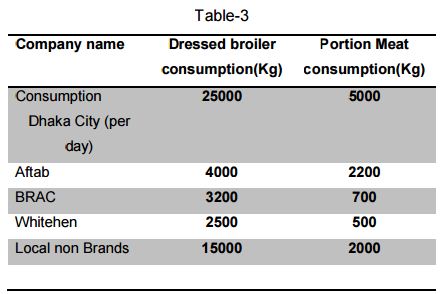
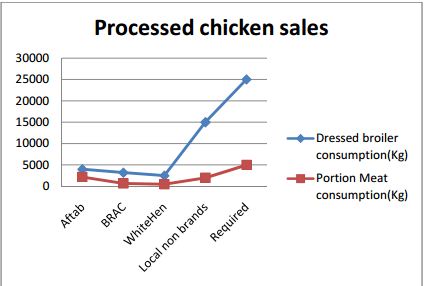
Table and figure- represents the daily processed chicken consumption in Dhaka city and the major suppliers of the dressed chicken and portion. The figure also represents the competitive position of the key suppliers. There is a supply deficit in the dressed chicken products market. And Aftab Bahumukhi Farms Ltd has a great opportunity to utilize its full capacity. In case of portion meat there is a positive supply condition.
Comparisons of Marketing strategies and practices of Competitors
Aftab Bahumukhi Farms ltd has a significant lacking in the company marketing practices and activities. A large number of problems were reviewed in the Marketing Mix section of this report. And figure: 1 represents the promotional activities performed by the company.
However, the strongest competitor ‘Rich’ practices a large amount of well planned marketing strategies. This company is looking forward to adapt all possible kind of promotional activities to enjoy 85% of the market share. Even Cpthe competitor uses shop signs, shop posters, leaflets and word of mouth influences as promotion.
Strengths of Rich in terms of Aftab Products
- Rich brand has a strong marketing and branding activities.
- There was a significant problem in the packaging of Aftab Products. Rich has better packs for their further processed products.
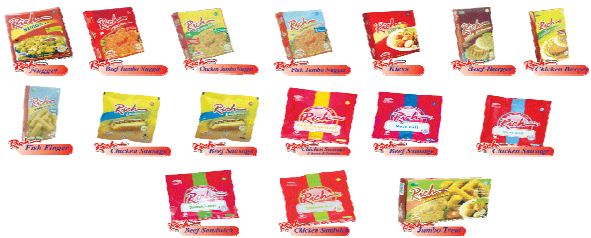
- The glossy packs attract customers more than the Aftab products can.
- Rich has strong promotional activities and they arrange continuous promotional programs.
- Rich has participated in super market promotion with Agora in 2008-09, international trade fair, Malaysian International Halal Showcase and also arranged School promotion program.
- The company has a well decorated website where different chicken recipes are added to attract household customers.
- Rich uses ASIATIC advertising agency for conducting promotional campaigns.
- It also exercises significant amount of social responsibilities.
Marketing Strategies for AfatbBahumukhi Farms Limited
After the whole analysis it is clear to all that Aftab Bahumukhi Farms Ltd. has enough resources and manpower to be the market leader both in processed and further processed chicken products. Due to the lacking in proper marketing strategies and practices, the company is losing its brand image and also the profitable market pie.
- In this situation there are some critical success factors to resolve the overall company problems that I would like to suggest on the basis of my personal judgments.
- Cool chain is the most important issue in frozen food products. Initially there is a need for four more vans of 3 ton capacity in Dhaka city, which will cover both Dhaka and Chittagong.
- Four more 1 to ½ MT capacity refrigerated vehicles will be required to carry frozen goods from the company sales centers to the distributors’ points.
- There is needed some more Aftab’s own outlets in Dhaka city.
- There are no particular and strict distributor selection rules. As the company is a quality producer having best distributor will enrich the company image as well as profits. Strong distributor rules will help to exercise enough control over them.
- There is a severe packaging problem. Some packaging facilities in the company sales center will reduce large amount of product return costs.
- Paper packets of further processed products can be replaced by air tight, shinny and glossy polythene packets. It will also increase brand images of the product and attract more customers.
- Manpower recruitment and training is another critical issue. Product size disorder from the factory requires more skilled and trained employees.
- An in- House HR department is absolutely necessary.
- Recruitment of marketing and branding team is the most critical issue.
- Undertaking Continuous promotional activities will increase company revenue and market share.
- Coordination among sales, marketing and production department is another critical success factor, which may be met by fortnightly coordination meetings to be held in Head Office.
- Last of all timely resource allocation is necessary to be more competitive.
Conclusions
Over the past three decades, the rapid expansion of global demand for processed foods has opened up lucrative export opportunities for agricultural source- rich developing countries. However, only a limited number of developing countries have been successful in exploiting these market opportunities. Thailand is one of such countries. A number of previous studies have alluded to the role played by multinational enterprises (MNEs) as a key factor behind this export success.
Aftab Bahumukhi Farms Limited is the only integrated and the largest poultry industry in Bangladesh that maintains the whole poultry chain in Bangladesh. And this company has the latest machineries and expertise to provide quality products to the country as well as can export in the international market. In Bangladesh processed foods are getting popularity like other country. And it’s a great opportunity for Aftab farm as its products are processed and further processed chicken products. There exists a few key players in this industry and the whole Bangladesh can be a very profitable market for any company. Except Dhaka, Shylet and Chittagong, the 61 districts can become lucrative market for such product.
Appropriate planning, effective strategies and timely resource allocation can bring success for any company. Therefore Aftab Bahumukhi Farms Limited should develop better marketing strategies and polices to utilize its resources and make important contribution to the economy. As poultry is one of the most potential sector of our economy, more contribution of private companies will boost up it growth as well as the economy.
















